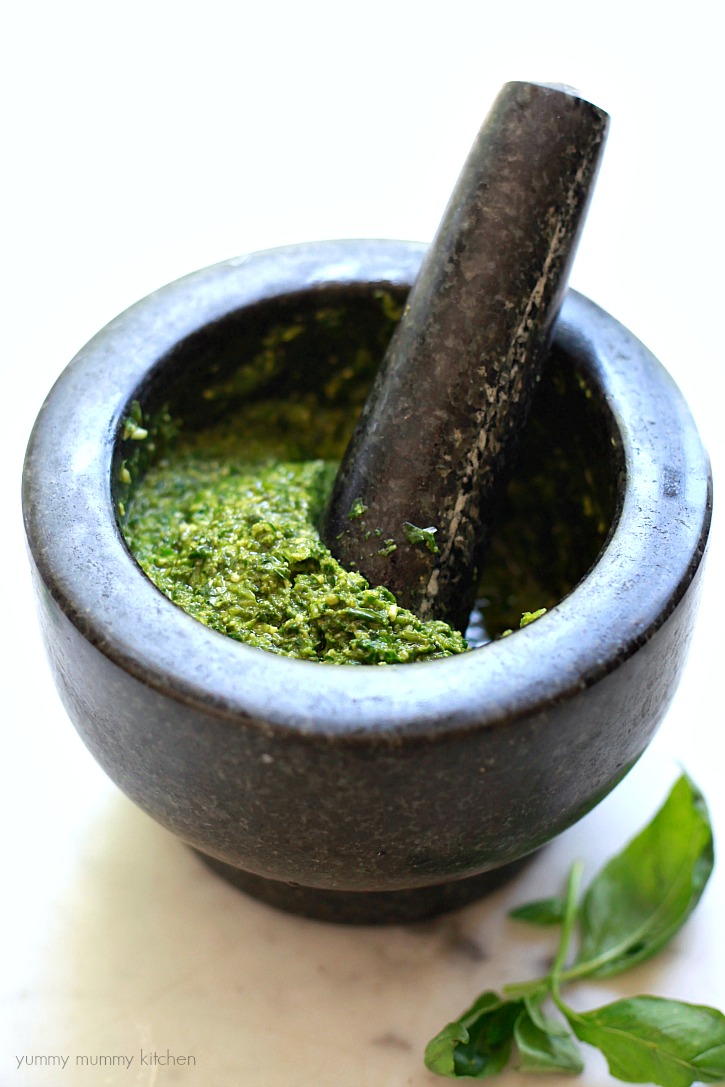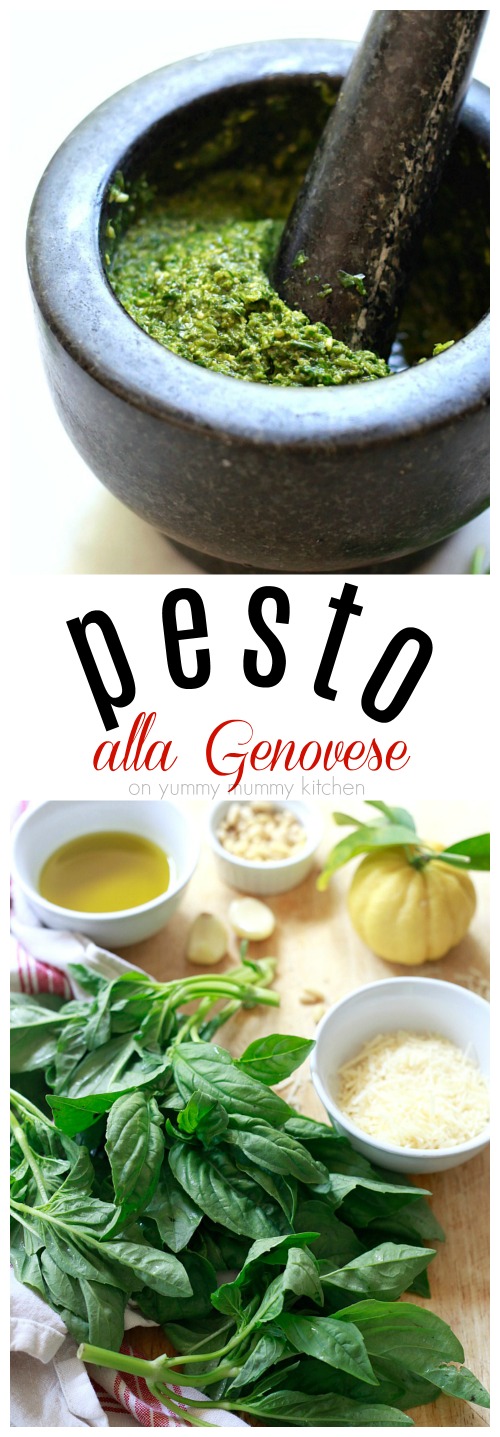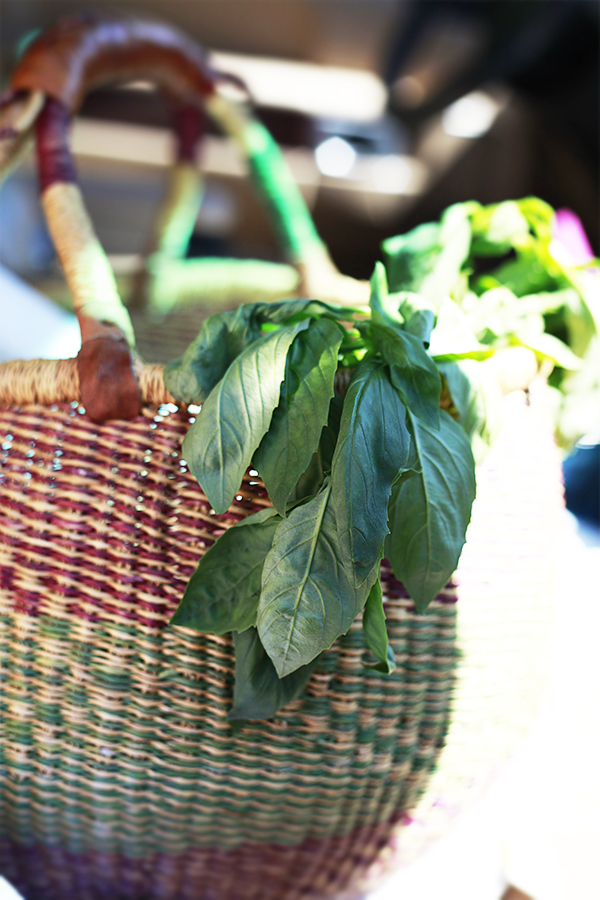How to Make Pesto with Fresh Basil (Pesto alla Genovese)
Add bright summery flavor and color to your dishes with this easy pesto recipe! Get the classic Pesto alla Genovese recipe, plus variations to make your pesto vegan, oil-free, and more.

Fresh Basil Pesto (Pesto alla Genovese)
School’s out for summer, and just like that, my garden has gone from spindly little starts to overflowing with bright, bushy greens. Every year I forget how quickly tiny seedlings turn into a jungle — kind of like kids. My eldest is somehow a fourth grader now, and I still can’t quite believe it.
Even if you don’t have room for raised beds or a full veggie patch, a small pot of herbs can be such a joy to grow. Basil, especially, thrives in the warm summer months, and nothing showcases it better than a batch of classic homemade pesto.
What is Pesto, Anyway?
Pesto is a traditional Italian sauce that originated in Genoa, Italy in the 16th century. The word comes from the Italian pestare, meaning “to pound” or “to crush,” because pesto was (and still often is) made by grinding ingredients together in a mortar and pestle.
In Italy, “pesto” can refer to any sauce made this way — like sun-dried tomato pesto — but the most iconic version is Pesto alla Genovese, made with fresh basil, pine nuts, garlic, Parmesan, and plenty of olive oil.
I love all the regions of Italy I’ve traveled to, but Liguria — with Genoa at its heart — is especially stunning. Since I’ll be heading back later this month, it feels like the perfect time to revisit and master this Italian staple at home.
How to Make Classic Basil Pesto
Traditional pesto doesn’t include lemon, but I like to add a squeeze to brighten the flavor and help slow down browning. Since lemons grow abundantly in Liguria, it feels right at home here too.
The beauty of pesto is that it’s more art than science — you don’t have to measure with precision. Tradition says one clove of garlic per 30 basil leaves, but really, it’s about adjusting as you go until it tastes just right. While I adore the romance of using a mortar and pestle, I’ll admit that most days I pull out my food processor for ease.
Pesto Variations
- Vegan Pesto: Swap Parmesan for nutritional yeast to keep that nutty, cheesy flavor. Add an extra pinch of salt.
- Light Pesto: Replace some of the oil with water until you reach your preferred consistency.
- Kale or Spinach Pesto: Use half basil and half leafy greens for an extra nutrient boost.
- Walnut Pesto: Pine nuts can be expensive — walnuts are an affordable and delicious substitute.
How to Use Pesto
Homemade pesto is all about simple, fresh ingredients, so use the best basil, garlic, and olive oil you can find. Once it’s ready, there are endless ways to enjoy it:
- Tossed with warm pasta (loosen with a splash of pasta water to make it saucy).
- Spread on crusty bread, as they do in Cinque Terre.
- As a sandwich spread or pizza topping.
- Swirled into soups or drizzled over grilled veggies, fish, or chicken.
- Served cold for the brightest, freshest flavor.
Homemade pesto really is the taste of summer in a jar — and once you start making it, you’ll find a dozen delicious ways to enjoy it.
RECIPES THAT USE PESTO
Spring Veggie Minestrone Soup from Yummy Mummy Kitchen
Smashed Chickpea, Avocado, and Pesto Salad Sandwich from Two Peas and Their Pod
The Ultimate Veggie Sandwich from Edible Perspective
30 Minute Penne Pasta Salad from Minimalist Baker
Easy Mediterranean Pesto Chickpea Salad from Ambitious Kitchen
Roasted Potato Pesto Salad from Ceara’s Kitchen
Crispy Smashed Potatoes with Garlic Pesto from Minimalist Baker
Kale Detox Salad with Pesto from Well and Full
Pesto Butter Bean Salad from Deliciously Ella
Sheet Pan Roasted Vegetable Soup from Soup Addict
Grilled Flatbread with Peaches and Arugula Pesto from Foodie Crush
Spinach and Tomato Quesadilla with Pesto from The Garden Grazer
Spring Pesto Roasted Tomatoes from Garlic & Zest
Parmesan Pesto Risotto with Cherry Tomatoes from Whole and Heavenly Oven
Summer Pesto Grilled Vegetables with Penne from Whole and Heavenly Oven
Asparagus and Pea Spinach Pesto Quinoa Salad from Closet Cooking
If you liked this recipe, you might also like: How to Make Marinara with Fresh Tomatoes!
How to Make Pesto with Fresh Basil (Pesto alla Genovese)
Bright, herbaceous, and full of flavor, this classic basil pesto comes together in minutes with fresh basil, garlic, pine nuts, Parmesan, and olive oil. Whether you make it the traditional way with a mortar and pestle or in a food processor, this homemade pesto is the perfect sauce for pasta, spreading on sandwiches, or drizzling over roasted vegetables. A squeeze of lemon juice keeps it vibrant and fresh.

Ingredients
- 3-4 cups fresh basil leaves
- 2 cloves garlic
- 2 Tablespoons pine nuts
- 1/3 cup finely grated Parmesan cheese (or 3 tablespoons nutritional yeast)
- 1/4 cup extra virgin olive oil
- sea salt to taste
- squeeze of fresh lemon juice (optional)
Instructions
- Prep the basil: Wash and pat the basil leaves completely dry to avoid watery pesto.
- Mortar & Pestle Method (traditional): Place garlic and a small pinch of sea salt in a mortar. Grind to a paste. Add pine nuts and crush. Add basil a handful at a time, grinding in a circular motion. Stir in cheese, then drizzle in olive oil until the pesto reaches your desired consistency.
- Food Processor Method (quick): Add basil, garlic, pine nuts, and cheese to a food processor. Pulse until finely chopped. With the motor running, slowly drizzle in olive oil until smooth and creamy.
- Season & Finish: Taste and season with salt. Add a squeeze of lemon juice for brightness, if desired.
- Serve: Use immediately with pasta, on bread, or as a topping for proteins and vegetables.
Notes
Nutrition Information:
Yield: 6 Serving Size: 1Amount Per Serving: Calories: 143Total Fat: 13gSaturated Fat: 2gTrans Fat: 0gUnsaturated Fat: 10gCholesterol: 5mgSodium: 199mgCarbohydrates: 6gFiber: 1gSugar: 1gProtein: 4g












